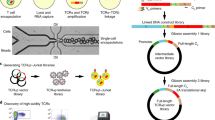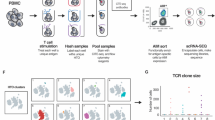Abstract
The use of fluorescently labeled major histocompatibility complex multimers has become an essential technique for analyzing disease- and therapy-induced T-cell immunity. Whereas classical major histocompatibility complex multimer analyses are well-suited for the detection of immune responses to a few epitopes, limitations on human-subject sample size preclude a comprehensive analysis of T-cell immunity. To address this issue, we developed a combinatorial encoding strategy that allows the parallel detection of a multitude of different T-cell populations in a single sample. Detection of T cells from peripheral blood by combinatorial encoding is as efficient as detection with conventionally labeled multimers but results in a substantially increased sensitivity and, most notably, allows comprehensive screens to be performed. We obtained proof of principle for the feasibility of large-scale screening of human material by analysis of human leukocyte antigen A3–restricted T-cell responses to known and potential melanoma-associated antigens in peripheral blood from individuals with melanoma.
This is a preview of subscription content, access via your institution
Access options
Subscribe to this journal
Receive 12 print issues and online access
$259.00 per year
only $21.58 per issue
Buy this article
- Purchase on Springer Link
- Instant access to full article PDF
Prices may be subject to local taxes which are calculated during checkout





Similar content being viewed by others
References
Arstila, T.P. et al. A direct estimate of the human alphabeta T cell receptor diversity. Science 286, 958–961 (1999).
Altman, J.D. et al. Phenotypic analysis of antigen-specific T lymphocytes. Science 274, 94–96 (1996).
Bakker, A.H. & Schumacher, T.N. MHC multimer technology: current status and future prospects. Curr. Opin. Immunol. 17, 428–433 (2005).
Chattopadhyay, P.K. et al. Quantum dot semiconductor nanocrystals for immunophenotyping by polychromatic flow cytometry. Nat. Med. 12, 972–977 (2006).
Haanen, J.B., Wolkers, M.C., Kruisbeek, A.M. & Schumacher, T.N. Selective expansion of cross-reactive CD8(+) memory T cells by viral variants. J. Exp. Med. 190, 1319–1328 (1999).
Toebes, M. et al. Design and use of conditional MHC class I ligands. Nat. Med. 12, 246–251 (2006).
Rodenko, B. et al. Generation of peptide-MHC class I complexes through UV-mediated ligand exchange. Nat. Protoc. 1, 1120–1132 (2006).
Bakker, A.H. et al. Conditional MHC class I ligands and peptide exchange technology for the human MHC gene products HLA-A1, -A3, -A11, and -B7. Proc. Natl. Acad. Sci. USA 105, 3825–3830 (2008).
Landis, J.R. & Koch, G.G. The measurement of observer agreement for categorical data. Biometrics 33, 159–174 (1977).
Appay, V. et al. Memory CD8+ T cells vary in differentiation phenotype in different persistent virus infections. Nat. Med. 8, 379–385 (2002).
Appay, V., van Lier, R.A., Sallusto, F. & Roederer, M. Phenotype and function of human T lymphocyte subsets: consensus and issues. Cytometry A 73, 975–983 (2008).
Kawakami, Y. et al. Identification of new melanoma epitopes on melanosomal proteins recognized by tumor infiltrating T lymphocytes restricted by HLA-A1, -A2, and -A3 alleles. J. Immunol. 161, 6985–6992 (1998).
Kawashima, I. et al. Identification of gp100-derived, melanoma-specific cytotoxic T-lymphocyte epitopes restricted by HLA-A3 supertype molecules by primary in vitro immunization with peptide-pulsed dendritic cells. Int. J. Cancer 78, 518–524 (1998).
Skipper, J.C. et al. Shared epitopes for HLA-A3–restricted melanoma-reactive human CTL include a naturally processed epitope from Pmel-17/gp100. J. Immunol. 157, 5027–5033 (1996).
Frickel, E.M. et al. Parasite stage-specific recognition of endogenous Toxoplasma gondii-derived CD8+ T cell epitopes. J. Infect. Dis. 198, 1625–1633 (2008).
Gredmark-Russ, S., Cheung, E.J., Isaacson, M.K., Ploegh, H.L. & Grotenbreg, G.M. The CD8 T-cell response against murine gammaherpesvirus 68 is directed toward a broad repertoire of epitopes from both early and late antigens. J. Virol. 82, 12205–12212 (2008).
Grotenbreg, G.M. et al. Discovery of CD8+ T cell epitopes in Chlamydia trachomatis infection through use of caged class I MHC tetramers. Proc. Natl. Acad. Sci. USA 105, 3831–3836 (2008).
Garboczi, D.N., Hung, D.T. & Wiley, D.C. HLA-A2–peptide complexes: refolding and crystallization of molecules expressed in Escherichia coli and complexed with single antigenic peptides. Proc. Natl. Acad. Sci. USA 89, 3429–3433 (1992).
van Oijen, M. et al. On the role of melanoma-specific CD8+ T-cell immunity in disease progression of advanced-stage melanoma patients. Clin. Cancer Res. 10, 4754–4760 (2004).
Acknowledgements
We thank B. Rodenko and H. Ovaa (Netherlands Cancer Institute) for the kind gift of J, W. van de Kasteele for help with cell culture, T. Wirenfeldt for statistical assistance, and A. Pfauth, F. van Diepen, M. van der Hoorn and G. de Roo for technical support with flow cytometry. This work was supported by the Danish Cancer Society grant DP06031 and the Carlsberg Foundation grant 2005-1-641 (to S.R.H.), Landsteiner Foundation of Blood Transfusion research grant 0522 and a Melanoma Research Alliance established investigator award (to T.N.S.) and Dutch Cancer Society grant UL 2007-3825 (to M.H.H. and T.N.M.S.).
Author information
Authors and Affiliations
Contributions
S.R.H., A.H.B. and C.J.S. designed research, performed research, analyzed data and wrote the paper; R.S.A. performed research and analyzed data; J.v.V. performed research; P.H. and E.C. provided practical assistance; P.t.S., C.B. and J.B.H. contributed material from individuals with melanoma; M.H.H., designed research and analyzed data; T.N.S., designed research, analyzed data and wrote the paper.
Corresponding author
Ethics declarations
Competing interests
The technology described in this manuscript is the subject of an EU patent application. Based on Netherlands Cancer Institute policy on management of intellectual property, S.R.H., A.H.B, C.J.S. and T.N.S would be entitled to a portion of received royalty income.
Supplementary information
Supplementary Text and Figures
Supplementary Figures 1–4 and Supplementary Tables 1–4 (PDF 433 kb)
Rights and permissions
About this article
Cite this article
Hadrup, S., Bakker, A., Shu, C. et al. Parallel detection of antigen-specific T-cell responses by multidimensional encoding of MHC multimers. Nat Methods 6, 520–526 (2009). https://doi.org/10.1038/nmeth.1345
Received:
Accepted:
Published:
Issue Date:
DOI: https://doi.org/10.1038/nmeth.1345
This article is cited by
-
Reassessing human MHC-I genetic diversity in T cell studies
Scientific Reports (2024)
-
A T cell receptor targeting a recurrent driver mutation in FLT3 mediates elimination of primary human acute myeloid leukemia in vivo
Nature Cancer (2023)
-
Nanoscale organization of two-dimensional multimeric pMHC reagents with DNA origami for CD8+ T cell detection
Nature Communications (2022)
-
Neoantigen-specific CD8 T cell responses in the peripheral blood following PD-L1 blockade might predict therapy outcome in metastatic urothelial carcinoma
Nature Communications (2022)
-
Tryptophan depletion results in tryptophan-to-phenylalanine substitutants
Nature (2022)



